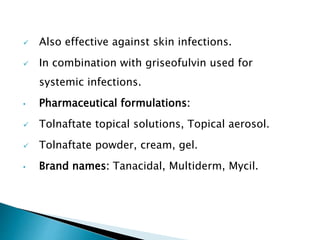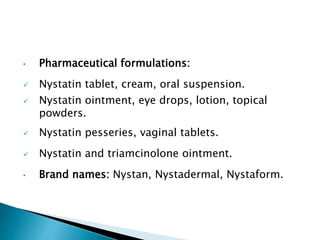Antifungal drugs
- 1. Presented by- Rahul Jadhav Anusaya Institute of Pharmacy, Swami- chincholi, Daund, Pune.
- 2. ïž Fungi are heterotropic microorganisms. ïž Differ from algae by lack of photosynthetic ability. ïž Differ from protozoa by lack of motility and possession of chitinous cell wall. ïž Differ from bacteria by greater size and possession of intracellular structure as nuclear membrane and mitochondria.
- 3. ïž Disease caused by fungi is called as mycosis. ïž Mycotic infection is divided in 3 groups - a) Dermiatophytosis: superficial skin infection caused by dermatophytes namely, epidermophyton, microsporum, trichophyton. Disease caused- Athlete's foot, ring worm of skin hair and nail. b) Candidiasis: Infection of skin and mucous membrane.
- 4. Caused by- Candida Albicans Disease caused- Candidiasis of skin, nails and mucous membrane. C) Certain saprophytes invade skin and causes lymphatic, pulmonary and systemic mycoses. Ingestion of saprophytic mushroom causes gastrotoxic, neurotoxic and heamolytic disease.
- 5. A) Synthetic compounds : 1. Carboxylic acid and their metallic salts: eg. Undecylenic acid, Zinc undacenonate. 2. Dyes: eg. Gentain (crystal) violet, Melachite green. 3. Phenolic compounds: eg. Salicylic acid. 4. Diamidines: eg. Stilbamidine 5. Thiocarbanilic acid derivatives: eg. Tolnaftate 6. Azoles: eg. Miconazole, Clotrimazole.
- 7. âĒ Physical properties: Colourless / pale brownish clear liquid / Yellowish white crystalline mass, characteristic odour and insoluble in water and suluble in alcohol and chloroform. âĒ Chemical properties: 1. KMnO4 solution decolourises, indicates presence of double bond in compound.
- 8. 2. Neutralised by sodium hydroxide giving sodium undecenoate. âĒ Stability and storage: Affected by light, hence stored in tightly closed light-resistant containers. âĒ Uses: 1. Used as fungicidal. 2. Used internally in treatment of - psoriasis, neuro dermatitis.
- 9. âĒ Pharmaceutical formulations: ïž Compound undecylenic acid ointment ïž Zinc undacenonate dusting powder âĒ Brand names: Mycota, Tineafex.
- 10. âĒ Physical properties: White to creamy-white powder, odourless / slight odour, insoluble in water, slightly soluble in alcohol but freely soluble in chloroform. âĒ Stability and storage: Stored in tightly closed containers. âĒ Uses: ïž It is topical antifungal used to treat various types of ringworms.
- 11. ïž Also effective against skin infections. ïž In combination with griseofulvin used for systemic infections. âĒ Pharmaceutical formulations: ïž Tolnaftate topical solutions, Topical aerosol. ïž Tolnaftate powder, cream, gel. âĒ Brand names: Tanacidal, Multiderm, Mycil.
- 12. âĒ Physical properties: Yellow to light brown powder, cereal like odour, slightly soluble in water and alcohol and hygroscopic in nature. âĒ Stability and storage: It is hygroscopic, affected by room temperature, light and air, hence stored in tightly closed light-resistant containers, temp. not exceeding 5° c.
- 13. âĒ Uses: ïž Used to treat Candidiasis of skin and mucous membrane. ïž For treat. of intestinal and oesophageal Candidiasis. ïž For Candidiasis of mouth. ïž For Candidiasis of vagina.
- 14. âĒ Pharmaceutical formulations: ïž Nystatin tablet, cream, oral suspension. ïž Nystatin ointment, eye drops, lotion, topical powders. ïž Nystatin pesseries, vaginal tablets. ïž Nystatin and triamcinolone ointment. âĒ Brand names: Nystan, Nystadermal, Nystaform.
- 15. âĒ Physical properties: Yellow to orange powder, odourless, almost tasteless. Insoluble in water and alcohol but soluble in dimethyl sulphoxide & propelene glycol. âĒ Chemical properties: ïž When treated with phosphoric acid, produces deep blue colour.
- 16. âĒ Stability and storage: Affected by light, air & room temp. Hence stored in tightly closed light- resistant containers at temp. 2°c to 10° c. âĒ Uses: ïž Effective against Mycotic infections including Candidiasis, blastomycocis, aspergillosis, phycomycosis, sporotrichosis, coccidioidomycosis.
- 17. ïž Used in treatment of - - Mucocutaneous, Cutaneous leishmaniasis and Candidiasis. - Primary amoebic meningoencephalitis. - Cryptococcal meningitis in combo with flucytosine. ïž Used for suppression of oral and intestinal Candidiasis. âĒ Pharmaceutical formulations: ïž Amphotericin B cream, lotion, lozenges, ointment,
- 18. âĒ Brand names: Fungizone, Fungilin. 5) Hamycin (Primamycin): âĒ Physical properties: Yellow amorphous powder, Insoluble in water and chloroform and soluble in pyridine and amphoteric in nature.
- 19. âĒ Chemical properties: When treated with conc. Sulphuric acid, gives stable blue colour. âĒ Stability and storage: Affected by light and air, hence stored in tightly closed light-resistant containers. âĒ Uses: ïž As antifungal and antitrichomonal activity. ïž Used topically and orally in vaginal infections.
- 20. âĒ Pharmaceutical formulations: ïž Hamycin ointment ïž Hamycin vaginal tablets âĒ Brand names: Imprina.




















